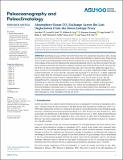Files in this item
Atmosphere-ocean CO2 exchange across the last deglaciation from the boron isotope proxy
Item metadata
| dc.contributor.author | Shao, Jun | |
| dc.contributor.author | Stott, Lowell D. | |
| dc.contributor.author | Gray, William R. | |
| dc.contributor.author | Greenop, Rosanna | |
| dc.contributor.author | Pecher, Ingo | |
| dc.contributor.author | Neil, Helen L. | |
| dc.contributor.author | Coffin, Richard B. | |
| dc.contributor.author | Davy, Bryan | |
| dc.contributor.author | Rae, James W. B. | |
| dc.date.accessioned | 2020-04-28T23:34:09Z | |
| dc.date.available | 2020-04-28T23:34:09Z | |
| dc.date.issued | 2019-10-29 | |
| dc.identifier | 261203329 | |
| dc.identifier | fc36d714-2ffd-4e03-8eb0-e9619aa704ef | |
| dc.identifier | 85074838180 | |
| dc.identifier | 000493036800001 | |
| dc.identifier.citation | Shao , J , Stott , L D , Gray , W R , Greenop , R , Pecher , I , Neil , H L , Coffin , R B , Davy , B & Rae , J W B 2019 , ' Atmosphere-ocean CO 2 exchange across the last deglaciation from the boron isotope proxy ' , Paleoceanography and Paleoclimatology , vol. Early View . https://doi.org/10.1029/2018PA003498 | en |
| dc.identifier.issn | 2572-4517 | |
| dc.identifier.other | RIS: urn:8B05A2B7EEC16B6A4BA5765B13383C72 | |
| dc.identifier.other | ORCID: /0000-0003-3904-2526/work/64361287 | |
| dc.identifier.uri | https://hdl.handle.net/10023/19867 | |
| dc.description | J. Shao and L.D. Stott were supported by an NSF grant (MG&G 1558990). W. R. Gray and R. Greenop were supported by NERC grants NE/N011716/1 and NE/N011716/1 to J.W.B. Rae. I. Pecher, H.L. Neil, and B. Davy were supported by RSNZ Marsden Fund grant UOA1022. R. Coffin was supported by a DOE-NETL contract to NRL subcontract to TAMUCC (#601970). | en |
| dc.description.abstract | Identifying processes within the Earth System that have modulated atmospheric pCO2 during each glacial cycle of the late Pleistocene stands as one of the grand challenges in climate science. The growing array of surface ocean pH estimates from the boron isotope proxy across the last glacial termination may reveal regions of the ocean that influenced the timing and magnitude of pCO2 rise. Here we present two new boron isotope records from the subtropical‐subpolar transition zone of the Southwest Pacific that span the last 20 kyr, as well as new radiocarbon data from the same cores. The new data suggest this region was a source of carbon to the atmosphere rather than a moderate sink as it is today. Significantly higher outgassing is observed between ~16.5‐14 kyrBP, associated with increasing δ13C and [CO3]2‐ at depth, suggesting loss of carbon from the intermediate ocean to the atmosphere. We use these new boron isotope records together with existing records to build a composite pH/pCO2 curve for the surface oceans. pH disequilibrium/CO2 outgassing was widespread throughout the last deglaciation, likely explained by upwelling of CO2 from the deep/intermediate ocean. During the Holocene, a smaller outgassing peak is observed at a time of relatively stable atmospheric CO2, which may be explained by regrowth of the terrestrial biosphere countering ocean CO2 release. Our stack is likely biased toward upwelling/CO2 source regions. Nevertheless, the composite pCO2 curve provides robust evidence that various parts of the ocean were releasing CO2 to the atmosphere over the last 25 kyr. | |
| dc.format.extent | 21 | |
| dc.format.extent | 17025965 | |
| dc.language.iso | eng | |
| dc.relation.ispartof | Paleoceanography and Paleoclimatology | en |
| dc.subject | GE Environmental Sciences | en |
| dc.subject | NDAS | en |
| dc.subject | SDG 13 - Climate Action | en |
| dc.subject | SDG 15 - Life on Land | en |
| dc.subject.lcc | GE | en |
| dc.title | Atmosphere-ocean CO2 exchange across the last deglaciation from the boron isotope proxy | en |
| dc.type | Journal article | en |
| dc.contributor.sponsor | NERC | en |
| dc.contributor.institution | University of St Andrews. School of Earth & Environmental Sciences | en |
| dc.contributor.institution | University of St Andrews. St Andrews Isotope Geochemistry | en |
| dc.identifier.doi | https://doi.org/10.1029/2018PA003498 | |
| dc.description.status | Peer reviewed | en |
| dc.date.embargoedUntil | 2020-04-29 | |
| dc.identifier.grantnumber | NE/N011716/1 | en |
This item appears in the following Collection(s)
Items in the St Andrews Research Repository are protected by copyright, with all rights reserved, unless otherwise indicated.

